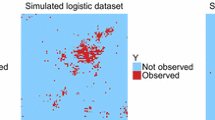Abstract
In binary spatial pattern recognition, there are many situations where the researcher could be interested in a number of dependent variables that are themselves correlated. For instance, different types of crime often coexist in the same area, or different species could share the same habitat. In cases like these, a natural correlation exists amongst the dependent variables of interest and is informative for spatial probability mapping. Weights of evidence (WE) modelling is a popular Bayesian probability method for binary pattern recognition, but it only deals with one single dependent variable at a time and ignores the correlation between the dependent variables. In this article, a multiple dependent variable weights of evidence (MDVWE) model will be developed. It will be shown that the new MDVWE model can be viewed as a restricted version of the conditional dependence-adjusted weights of evidence (CDAWE) model of Deng (Nat Resour Res 18(4):249–258, 2009). The MDVWE model is easy to program and implement. By means of a simulation study, it will be shown that the MDVWE model outperforms the traditional WE model both in terms of in-sample fit and out-of-sample prediction accuracy.


Similar content being viewed by others
References
Agterberg, F .P., 1992, Combining indicator patterns in weights of evidence modelling for resource evaluation: Nonrenew. Resour., v. 1, no. 1, p. 35–50.
Agterberg, F. P., Bonham-Carter, G. F., and Wright, D. F., 1990, Statistical pattern integration for mineral exploration, in Gaá, l. G., and Merriam, D. F., eds., Computer Applications in Resource Exploration Prediction and Assessment for Metals and Petroleum: Pergamon, Oxford, p. 1–21.
Agterberg, F. P., Bonham-Carter, G. F., Wright, D. F., and Cheng, Q., 1993, Weights of evidence modelling and weighted logistic regression for mineral potential mapping, in Davis, J. C., and Herzfeld, U. C., eds., Computers in Geology, 25 Years of Progress: Oxford University Press, p. 13–32.
Amemiya, T., 1981, Qualitative response models: a survey: J. Econ. Lit., v. 19, p. 1483–1536.
Bonham-Carter, G. F., 1994, Geographic information systems for geoscientists: Pergamon, Oxford, 398 p.
Bonham-Carter, G. F., Agterberg, F. P., and Wright, D. F., 1988, Integration of geological datasets for gold exploration in Nova Scotia: Photogram. Remote Sensing, v. 54, no. 11, p. 1585–1592.
Bonham-Carter, G. F., Agterberg, F. P., and Wright, D. F., 1989, Weights of evidence modelling: a new approach to mapping mineral potential, in Agterberg, F. P., and Bonham-Carter, G. F., eds., Statistical Applications in the Earth Sciences: Geological Survey Canada Paper 9-9, p. 171–183.
Deng, M., 2009, A conditional dependence adjusted weights of evidence model: Nat. Resour. Res. v. 18, no. 4, p. 249–258.
Emelyanova, I. V., Donald, G. E., Miron, D. J., Henry, D. A., and Garner, M. G., 2008, Probabilistic modelling of cattle farm distribution in Australia: Environ. Model. Assess. v. 14, p. 449–465.
Hansen, D. T., 2000, Describing GIS applications: spatial statistics and weights of evidence extension to ArcView in the analysis of the distribution of archeology sites in the landscape, in Proceedings of the 20th Annual ESRI International User Conference, San Diego, CA.
Hansen, D. T., West, J., Simpson, B., and Welch, P., 2002, Modeling spatial uncertainty in analysis of archeological site distribution, in Proceedings of the 22nd Annual ESRI International User Conference, San Diego, CA.
Romero-Calcerrada, R., and Luque, S., 2006, Habitat quality assessment using weights-of-evidence based GIS modelling: the case of Picoides tridactylus as species indicator of the biodiversity value of the Finnish forest: Ecol. Model. v. 196, p. 62–76.
Sawatzky, D. L., Raines, G. L., Bonham-Carter, G. F., and Looney, C. G., 2007, Spatial data modeller (SDM): ArcMAP 9.2 geoprocessing tools for spatial data modelling using weights of evidence, logistic regression, fuzzy logic and neural networks: http://www.arcscripts.esri.com/details.asp?dbid=15341.
Author information
Authors and Affiliations
Corresponding author
Rights and permissions
About this article
Cite this article
Deng, M. Binary Pattern Recognition in the Presence of Correlated Multiple Dependent Variables. Nat Resour Res 19, 269–278 (2010). https://doi.org/10.1007/s11053-010-9128-7
Received:
Accepted:
Published:
Issue Date:
DOI: https://doi.org/10.1007/s11053-010-9128-7




